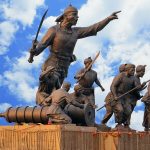Every spring, India comes alive with the vibrant and joyous celebration of Holi, the Hindu festival of colors. This exuberant festival, celebrated on the full-moon day of the Hindu month of Phalguna, transcends societal boundaries, bringing together people of all ages, castes, and statuses in a kaleidoscope of color and joy. On this special day, the air is filled with laughter and the splashes of colored water and powders, as everyone becomes a canvas for the brilliant hues of Holi.
Holi’s origins are deeply rooted in Indian mythology, and its traditions vary across the country. One of the most prominent legends associated with Holi is the story of Hiranyakashipu, a demon king from ancient times. According to the myth, Hiranyakashipu sought to kill his devout son Prahlada, a fervent worshipper of the deity Vishnu. The king enlisted his sister, Holika, who possessed a magical cloak that rendered her immune to fire. Holika sat on a pyre with Prahlada, but the cloak protected the boy instead, leaving Holika to perish in the flames. That night, Vishnu killed Hiranyakashipu, symbolizing the triumph of good over evil. In commemoration of this event, large pyres are lit on the eve of Holi, known as Holika Dahan, symbolizing the victory of light over darkness. In other regions, the story of Krishna and Radha takes center stage. Krishna, a beloved deity and an incarnation of Vishnu, was known for his playful and mischievous nature. He fell in love with Radha, a fair-skinned milkmaid, and feeling self-conscious about his dark blue complexion, he playfully smeared her face with color to make them equals. This playful act is believed to be the origin of the tradition of throwing colored powders and water, embodying the spirit of fun and playfulness that Krishna represents.
One of the most renowned celebrations of Holi takes place in the Braj region of Uttar Pradesh, which includes Mathura, Vrindavan, Gowardhan, Gokul, Nandagaon, and Barsana. This area holds special significance as the birthplace of Lord Krishna, and the Holi festivities here are unparalleled. The Braj Ki Holi spans two days, beginning with Holika Dahan and followed by the vibrant celebrations of colors. The region hosts a series of unique rituals, including the famous Lathmar Holi in Barsana, where women playfully beat men with sticks while the men protect themselves with shields. Over the 40 days leading up to Holi, the temples in Braj are filled with daily festivities, culminating in a week-long explosion of color and joy.
Visitors to India during Holi can immerse themselves in this cultural extravaganza, experiencing the diverse ways in which this festival is celebrated across the country. From the traditional bonfires of Holika Dahan to the riotous color fights, Holi offers a sensory feast that captures the essence of India’s rich cultural heritage. Whether you’re in the narrow lanes of Mathura, the ghats of Varanasi, or the bustling streets of Delhi, the spirit of Holi unites everyone in a celebration of life, love, and the eternal victory of good over evil.
Experience the magic of Holi and be a part of this joyous festival that paints India in the brightest of colors, creating memories that will last a lifetime.


